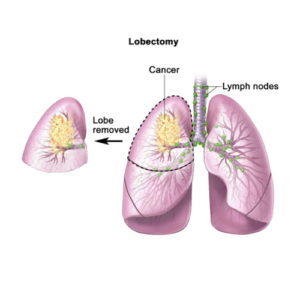What Is a Lobectomy?
The lobes of your lungs are made up of several portions. There are three lobes in the right lung and two in the left lung. A lobectomy is a type of lung cancer surgery that involves removing one lobe of the lung due to the presence of cancerous tumors. Other disorders that may necessitate include TB, severe COPD, or damage to the lungs that affects major blood arteries.
Procedures are divided into two categories. Understanding the necessary preparation, healing process, potential problems, and prognosis following a lobectomy is necessary for deciding if one of these procedures is the correct course of treatment for you.
What is the Purpose of a Lobectomy?
A lobectomy is a surgical procedure that involves the removal of a diseased or damaged section of the lung, most commonly owing to lung cancer. This procedure is mostly used to treat non-small cell lung cancer (NSCLC) in which the tumor is limited to a single lobe.
Compared to a pneumonectomy, which entails removing a complete lung, this treatment is less intrusive and preserves greater lung function. In comparison, a wedge resection, which removes the tumor plus a little quantity of surrounding tissue, is slightly more comprehensive.
What are the Types of Lobectomy?
A lobe of your lung might be removed in a variety of ways.
Video-Assisted Thoracoscopic Surgery (VATS)
With the use of equipment and a camera, a lobe of the lung is removed through a few tiny incisions in the chest. This treatment is rapidly becoming the method of choice. For stage 1 or stage 2 non-small cell lung cancer, a VATS lobectomy may be explored (NSCLC).
When compared to an open lobectomy, a VATS lobectomy may have less consequences.
Robot-Assisted Thoracoscopic Surgery (RATS)
RATS, which is similar to VATS but is done using robots, looks to have less issues and shorter hospital stays after a lobectomy. It has been used successfully with stage 3 NSCLC, although whether it delivers a better result is still debated.
Open Lobectomy
A large incision on the side of the chest is used to remove a lobe of the lungs. To gain access to the lungs, the ribs must be stretched apart. When your heart specialist wants to remove bigger stage 2 and stage 3 tumours from the lungs and lymph nodes, this type of surgery is frequently performed.
Potential Risks of Lobectomy
A lobectomy is a significant surgical treatment with a high risk of complications. Prior to surgery, your heart specialist will go through these with you.
The following are some of the possible complications:
- Infections, such as pneumonia
- Bleeding
- Heart problems
- DVTs are blood clots in the legs that can migrate to the lungs.
- A chest tube was remained in place for more than three to four days because of a prolonged air leak. This is the most common complication.
Traditional open lobectomy, according to some studies, has a substantially greater risk of post-operative problems. VATS complications are expected to occur between 6% and 34.2 % of the time, but open lobectomy complications might be as high as 58 percent.
Procedure
A lobectomy is conducted under general anaesthesia in the operating room, so you will sleep through the surgery. Antibiotics may be administered intravenously before or after surgery.
A ventilator with a breathing tube inserted into your neck will be used, and a catheter may be used to empty urine during and after the treatment. Throughout the procedure, your heart rate, blood pressure, and respiration will be monitored.
If you are undergoing a VATS or RATS procedure, Around the lobe area, three or four tiny incisions will be done. The thoracoscope, a little tube containing a light and a tiny camera that may be put into the chest cavity, can then be used. It sends photos to a computer screen so the heart surgeon can see what’s going on.
The troublesome tissue is subsequently removed using surgical tools put via the other incisions. A chest tube will be inserted into the surgical area after either procedure to allow excess fluid and air to drain outside of the chest for a length of time. Stitches or staples will be used to close the incision(s).
If you are undergoing an open lobectomy, On the side of the body where the tissue is being removed, an incision will be made. The cut will most likely begin at the nipple on the front of your chest and wrap across your back to the area beneath the shoulder blade.
The ribs will be spread apart using an instrument. The tissue will be removed and the wound will be closed with stitches or staples.
Recovery After Lobectomy
You will be monitored in the intensive care unit (ICU) for a day or two after your lobectomy before being transferred to a regular hospital room. You’ll be working with a respiratory therapist who will ask you to take deep breaths and breathe through an incentive spirometer.
As soon as you are able, the nursing team will assist you in getting up and moving around. Depending on the type of lobectomy performed, most patients spend four to seven days in the hospital, barring problems. for more information please visit

